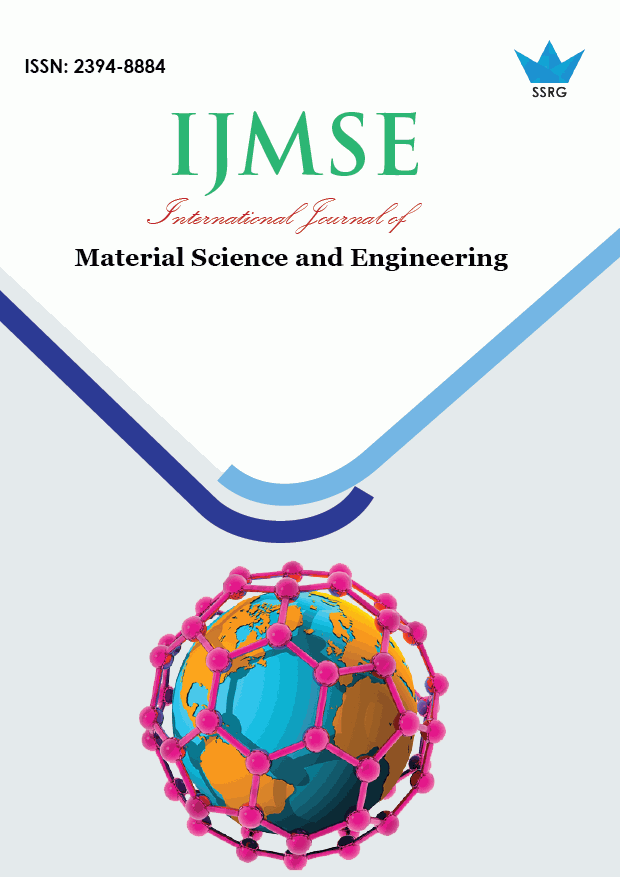Limitation of Aluminum Anode in Cathodic Protection Applications

| International Journal of Material Science and Engineering |
| © 2024 by SSRG - IJMSE Journal |
| Volume 10 Issue 2 |
| Year of Publication : 2024 |
| Authors : Ahmed Mahgoub, Ghallib Houtan |
How to Cite?
Ahmed Mahgoub, Ghallib Houtan, "Limitation of Aluminum Anode in Cathodic Protection Applications," SSRG International Journal of Material Science and Engineering, vol. 10, no. 2, pp. 10-18, 2024. Crossref, https://doi.org/10.14445/23948884/IJMSE-V10I2P102
Abstract:
The commonly employed method for Cathodic Protection (CP) is the sacrificial anode system. This method involves protecting the metallic structure by sacrificing other metals that are more reactive. In this process, electrons are transferred from the sacrificial metal (which has more negative potential) to the protected metallic structure (which has more positive potential) through corrosive electrolytes using a connecting conductor. An aluminum (Al) anode is a sacrificial anode made of aluminum. Al alloy anodes have been utilized for several decades, mostly in large cathodic protection projects such as ports, subsea structures, ship hulls, and piling installations. This was attributed to the superior performance of Al in comparison to zinc (Zn), which surpassed the cost difference in larger projects. Nevertheless, the electrochemical characteristics of Zn are regarded as more stable than theirs. This study aims to highlight the constraints of the Al anode under different environmental and application conditions and elucidate the potential risks associated with the utilization of this particular sacrificial anode. Furthermore, it could serve as a scientific reference for the selection of a galvanic anode system.
Keywords:
Corrosion, Cathodic Protection, Galvanic Anode, Aluminum Alloy.
References:
[1] C.F. Schrieber, R.W. Murray, “Supplementary Studies of the Galvalum III Anode—Hot Saline Mud and Brine Environments,” Materials Performance Magazine, vol. 20, no. 3, pp. 19-23, 1981.
[Google Scholar] [Publisher Link]
[2] Kola Fagbayi, and David Scantlebury, “Adverse Effect of Temperature on the operating-Potential Behavior of Al–Zn–In Anodes,” Journal of Corrosion Science and Engineering, vol. 4, pp. 1-12, 2003.
[Google Scholar] [Publisher Link]
[3] NACE TM0190-2022, “Impressed Current Laboratory Testing of Aluminum and Zinc Alloy Anodes,” AMPP Store, 2022.
[Google Scholar] [Publisher Link]
[4] ISO 15589-2:2024, Oil and Gas Industries Including Lower Carbon Energy-Cathodic Protection of Pipeline Transportation Systems, Part 2: Offshore Pipelines, 2024. [Online]. Available: https://www.iso.org/standard/80267.html.
[5] DNV-RP-F103 Cathodic Protection of Submarine Pipelines, DNV, 2021. [Online]. Available: https://www.scribd.com/document/641465268/DNV-RP-F103
[6] Fischer, K.P. Corrosion 1991, NACE, Paper No. 235, Cincinnati, 1991.
[7] Grant Gibson, “Behavior of Al-Zn-In anodes at Elevated Temperature,” Nace Corrosion, 2010.
[Google Scholar] [Publisher Link]
[8] F. Bolzoni et al., “Effectiveness of Aluminum Anodes for Cathodic Protection in Low Chloride Environments,” Nace Corrosion, 2008.
[Google Scholar] [Publisher Link]
[9] Ahmed Wahba Mahgoub, “Direct Electrical Heating Impaction for Subsea Pipeline Integrity,” Materials Performance Magazine, vol. 60, no. 4, pp. 28-31, 2021.
[Publisher Link]
[10] J.F. Williams, Alternating Current and Aluminum, Materials Protection, pp. 50-52, 1967.
[11] Kari Forthun, “Alternating Current Corrosion of Aluminum Sacrificial Anodes,” NTNU Open, Master Thesis, Institute of Materials Technology, 2013.
[Google Scholar] [Publisher Link]
[12] Det Norske Veritas, “Cathodic Protection Design,” Recommended Practice DNV-RP-B401, 2010.
[Google Scholar] [Publisher Link]
[13] Andreas Thorsteinsen. “Alternating Current Corrosion of Cathodically Protected Steel in Marine Environment,” NTNU, Master Degree, 2012.
[14] Sven Morten Hesjevik, and Stein Olsen, “Cathodic Protection Design of Submarine Pipelines with Direct Electric Heating,” Nace Corrosion, 2013.
[Google Scholar] [Publisher Link]
[15] Alex Delwiche, Patrick Lydon, and Isaac Tavares, “Concerns Over Utilizing Aluminum Alloy Anodes in Sealed Environments,” Nace Corrosion, 2017.
[Google Scholar] [Publisher Link]
[16] Stein T. Briskeby, Linda Børvik, and Sven M. Hesjevik, “Cathodic Protection in Closed Compartments-pH Effect and Performance of Anode Materials,” Nace Corrosion, 2015.
[Google Scholar] [Publisher Link]
[17] Likun Xu et al., “Performance of Aluminum Alloy Sacrificial Anode under Cyclic Immersion in Seawater,” Nace Corrosion, 2010.
[Google Scholar] [Publisher Link]
[18] DNV-RP-B101. Corrosion Protection of Floating Production and Storage Units, 2019. [Online]. Available: https://store.accuristech.com/standards/dnv-dnv-rp-b101?product_id=2793681.
[19] Cédric Gabelle et al., “The Impact of Aluminum Sacrificial Anodes on the Marine Environment: A Case Study,” Applied Geochemistry, vol. 27, no. 10, pp. 2088-2095, 2012.
[CrossRef] [Google Scholar] [Publisher Link]
[20] B.O. Rosseland, T. D. Eldhuset, and M. Staurnes, “Environmental Effects of Aluminum,” Environmental Geochemistry and Health, vol. 12, pp. 17-27, 1990.
[CrossRef] [Google Scholar] [Publisher Link]
[21] Lydia Leleyter et al., “Fate of Aluminum Released by Sacrificial Anodes-Contamination of Marine Sediments by Environmentally Available Compounds,” Comptes Rendus Geoscience, vol. 350, no. 5, pp. 195-201, 2018.
[CrossRef] [Google Scholar] [Publisher Link]
[22] Christelle Caplat et al., “Comparative Toxicities of Aluminum and Zinc From Sacrificial Anodes or From Sulfate Salt in Sea Urchin Embryos and Sperm,” Ecotoxicology and Environmental Safety, vol. 73, no. 6, pp. 1138-1143, 2010.
[CrossRef] [Google Scholar] [Publisher Link]
[23] BS EN 12496:2013, Galvanic Anodes for Cathodic Protection in Seawater and Saline Mud, European Standards, 2013. [Online]. Available: https://www.en-standard.eu/bs-en-12496-2013-galvanic-anodes-for-cathodic-protection-in-seawater-and-saline-mud/.

 10.14445/23948884/IJMSE-V10I2P102
10.14445/23948884/IJMSE-V10I2P102